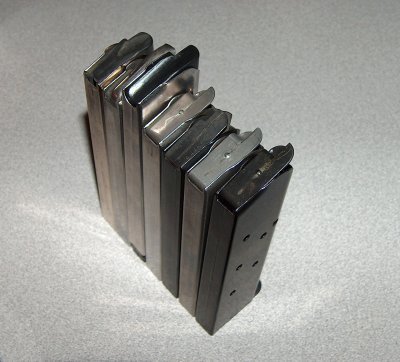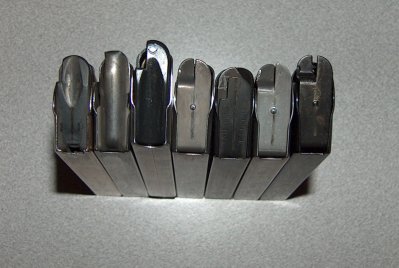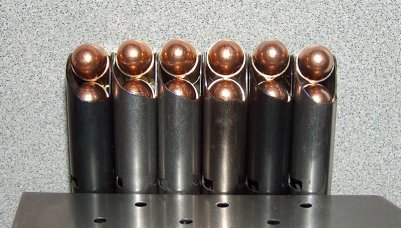Gross Anatomy
Feeding Time
Following Up
Conclusion
Frequently Asked Questions
Errata and Clarifications
Appendix: More Magazines
More articles
Discuss this article at

Gross Anatomy
I have the following brands of magazines to work with: Para-Ordnance, Metalform, Wilson Combat, Springfield Armory, Colt, another Metalform, and another Colt. (This is the order they appear in the first two photos on the page.)

The unusual suspects.
The Para-Ordnance is the OEM magazine included with the SSP. It uses a plastic follower with a groove on its forward section. The Metalform mag uses a rounded follower with an enclosed front, the kind often recommended to people with aluminum-framed 1911 who are worried about the traditional split follower gouging into the frame ramp. Third from the left is the famous (or infamous, depending on one's point of view) Wilson 47D, which uses a "self-lubricating" nylon follower with a deep channel cut in it. The middle mag is one I dug out of my range bag, a stainless steel Springfield Armory magazine that came with my Mil-Spec. It's the first of the magazines to use the traditional flat follower with a dimple on it and a bent lower leg. The Colt to its right looks similar on casual inspection, but the follower here is flat and bent in the back to form the lower section. We return to tradition with the second-to-last magazine, a Metalform that's pretty much the same as the Springfield in design, but much different in execution. (More on that later.) Finally, we have my newest acquisition, a Colt factory magazine. This mag uses yet another split, dimpled follower, but its feed lips are tapered instead of parallel. This kind of magazine is sometimes referred to as a hybrid magazine, and since "hybrid" is easier to type than "my new Colt magazine with tapered lips and a split follower, not to be confused with the other Colt magazine that has parallel lips and a flat follower", that's what I'm going to call it.

Which follower is the leader?
The first thing that jumped out at me when looking at these magazines was how different they all were. It's a trivial observation, but when you consider that every one is designed to do the same thing, the presence of so much variety should raise some flags. Follower construction uses metal or plastic to form dimpled, flat or recessed shapes that are then seated at different angles in the magazine bodies. The feed lips are strongly tapered, lightly tapered, or parallel, and feature release points that range from gentle flares to abrupt edges.

Left to right: Colt, Wilson, Metalform, Para, Colt hybrid, Springfield
The result of all this variety in the magazines' construction is corresponding variety in the way they present the top round. In the photo above, the magazines are all indexed by their mag catch slots to eliminate any variance due to magazine length, leaving only their own variances displayed. The highest cartridge angle award goes to the Colt hybrid second from the right; we can thank the tapered feed lips for that. The rounds that actually sit the highest are found in the Para mag directly to the left of the Colt hybrid, but the angle found here is lower than the hybrid's (probably because the groove in the front part of the follower lets the front of the cartridge sit lower). The Metalform with the rounded follower (third from the left) gets a higher angle than the Para, but the rounds don't sit as high up; in fact, it looks really similar to the Wilson on its left. Finally, there are the Colt with the flat follower and the Springfield (far left and right, respectively): These have similar feed lip construction (in fact, the Springfield's are more restrictive), but the Colt presents its rounds at a lower angle. My bet is that the Colt's follower doesn't support the front of the round as much.
These difference can and do affect the kinematics of feeding, but the question is to what extent this matters. Let's find out, shall we?
email: hidi.projects at gmail.com